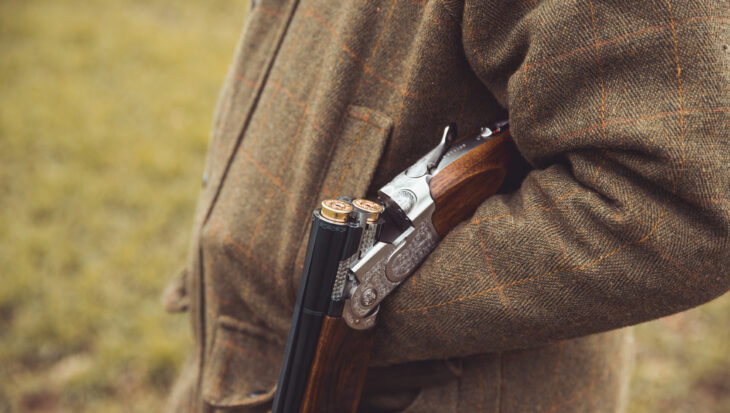Ban on the use of lead shot – finally!
Posted 10 Jul 2025

Posted on the 3rd February 2015
Animal Aid placed secret, fly-on-the-wall cameras at Bowood Yorkshire Lamb slaughterhouse, Thirsk, and filmed on December 1st and 2nd, then returned and placed the camera at a different angle and filmed again on 9th December.
We filmed 4041 sheep; four conveyor operators and two slaughtermen.
All six men were filmed breaking animal welfare laws.
A chute delivers sheep (often at speed) to the slaughter area. They drop from the chute (where they cannot move their legs) onto a slippery slatted floor, directly in front of a solid central upright structure (part of the conveyor system). The only way they can be protected from it is by the conveyor operator directing them with his legs or body. This can cause as many problems as it prevents. Often, however, they hit the solid upright head on. Many sheep fall and cannot get up.
Our film shows three significant layout problems:
This area is held together with pallets and string; drips fall from the ceiling; and cups of hot drinks are balanced on top of the electric box. The infrastructure here is guaranteed to cause suffering to the sheep and encourages aggression by frustrated conveyor operators, and yet this slaughterhouse has been approved by the government. A government-appointed vet continues to work within this slaughterhouse and has, we assume, turned a blind eye to the fundamental welfare breaches caused by the design.
Animal Aid:
Such an appalling design and construction means the conveyor operators routinely have to pick up fallen sheep, who may have been hurt by the fall and who are unable to get to their feet. Clearly, many of these sheep are frightened and panicking. Our footage shows the best practice we were able to film, as one conveyor operator struggled to cope with the terrible design and construction.
In this section of our film, we have shown the best practice by the worker least prone to violent actions. In it, he has to direct the sheep using his legs, and is forced to bend to pick up sheep who have fallen and get them onto the conveyor.
That he has to operate two conveyors while at the same time direct the sheep who arrive behind him means that there is always room for error. In this case, the conveyor is not stopped soon enough and a sheep is taken straight off the end. She is seen in the background running through the slaughterhouse. Some time later, she reappears on camera – but on the wrong side of the pallets, tied together with string, that form the walls. She is picked up by her fleece and dragged back over the pallets to be slaughtered.
‘Compassion and animal welfare stand at the centre of the entire process’ – Shuja Shafi and Jonathan Arkush, writing in defence of religious slaughter, 6 March 2014
All of the four conveyor operators we filmed showed varying degrees of aggression and violence towards the sheep, and both slaughtermen witnessed this daily violence without appearing surprised or concerned about it. On just one occasion – the fifth clip in our film – did a slaughterman appear uncomfortable with the threat of violence, shaking his head at the conveyor operator. On all other occasions – and we reported hundreds of incidents to the Food Standards Agency – the slaughtermen appeared accepting of the violence, suggesting it is both systemic and ‘normal’ – note the first clip.
Our film shows 31 clips of violence, although many more have been reported to the Food Standards Agency, including a sheep being kicked in the face before the worker stands on her neck, then bounces up and down. She wriggles free and hides in a corner where he leaves her. After processing two more sheep – one of whom he shouts at while grabbing her fleece and throwing her – he turns his attention back to the one in the corner. He grabs her by a foreleg, then hurls her at the conveyor, which she hits with considerable force.
It also shows:
There are four examples of callousness and contempt in this film.
Halal meat is produced through ritual slaughter known as dhabihah, which requires that the animals are killed by ‘a single cut with a surgically sharp knife’. While this was the case for many of the sheep we filmed, there were also many cases where sheep endured terrible sawing or hacking at their throats.
This film shows just a few of the very many examples.
Under the current slaughter regulations – Welfare of Animals (Slaughter or Killing) – it is an offence to move sheep for 20 seconds after their throats have been cut. This is because they may still be conscious and further ‘dressing’ would add to their suffering. We analysed the first 500 sheep we filmed and recorded the time from the cut until they were shunted off the end of the conveyor.
Of the 500 sheep observed, 431 (86.2%) were shunted off the conveyor less than twenty seconds after being cut:

For those sheep who were moved less than twenty seconds after being cut, the average (mean) duration between cut and fall was 12.85 seconds, more than seven seconds below the twenty second duration required for the animal to lose consciousness.
Several sheep were pulled off immediately after being cut and many more almost immediately after being cut.
The distribution of the 431 sheep who fell less than twenty seconds after being cut is as follows:

This film gives just a few examples of the thousands we filmed, including both slaughtermen using their legs to drag the sheep off the conveyor. In some cases, the slaughtermen hadn’t even let go of the sheep’s heads before they fall.
There are differing opinions on what can be considered halal. Some Muslims accept stunning; some don’t. Most expect prayer to be said or played on a recording; others say it doesn’t matter. But the bedrock of religious slaughter is that of respect for the animals’ ‘sacrifice’. We filmed many practices at Bowood Yorkshire Lamb that would defy expectations of what both Muslims and non-Muslims believe halal slaughter to be.
Under most definitions of what can be considered halal, animals should not see the knife, nor should they see other animals slaughtered. But at Bowood Yorkshire Lamb, slaughtermen regularly sharpened the knife in front of the sheep on the conveyor, and the sheep behind would see the animal in front get cut. Those at the front of the conveyor would see other animals bleeding out on the floor in front of them, before being shackled and hoisted. The nine clips in this section demonstrate these common problems.
Neither slaughterman prayed as he killed the animals (in fact, they often chatted together while they killed) but, instead, the radio blared out across the slaughterhouse. As we filmed in December, there were many instances of Christmas songs playing. Workers chimed in shouting ‘ho ho ho, merry Christmas’ and singing along.
(Our film shows sheep being slaughtered while these Christmas songs played: Band Aid 30, ‘Do they know it’s Christmas?’; George Michael, ‘Last Christmas’; Slade, ‘Merry Xmas Everybody’; and The Pogues and Kirsty MacColl, ‘Fairytale of New York’.)
This quote comes from a Reuven Yaacobov, a rabbi defending both kosher and non-stun halal slaughter in 2012.
This section of our film shows:
Posted 10 Jul 2025

Temperatures are rising and it’s time to get outdoors, enjoy the weather and tuck into some delicious vegan food! Thanks to an abundance of plant-based options now available, there’s an alfresco option for every tastebud...
Posted 09 Jul 2025
